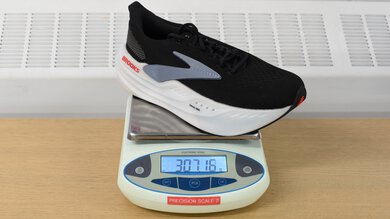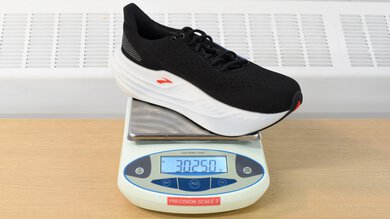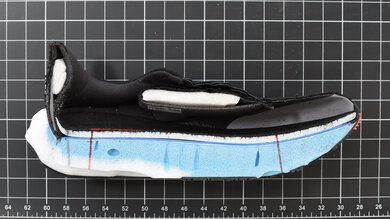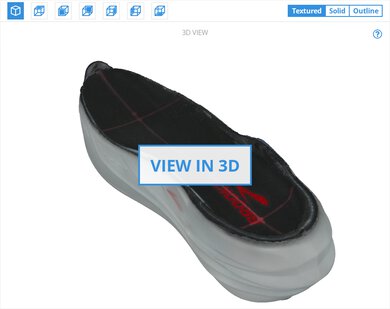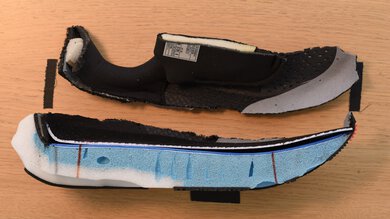The Brooks Glycerin Max is the Cadillac of running shoes—heavy, bulky, and ostentatious—which makes for a remarkably comfortable ride. Its substantial build pairs with an ultra-high stack height to deliver the plush comfort that maximalist runners crave for leisurely recovery miles. Featuring Brooks' DNA-Tuned foam, the shoe offers very good cushioning that absorbs impact smoothly, turning every run into a gentle cruise. While its substantial profile and weight mean it's far from delivering optimal performance, the Glycerin Max truly excels in providing a supremely comfortable and relaxed ride, perfect for runners prioritizing softness and comfort above speed.
Our Verdict
The Brooks Glycerin Max isn't designed for marathon racing and performs poorly if used for this purpose. Its inadequate energy return makes each stride feel inefficient and tiring, and its heavier build significantly hampers performance over long distances. Although the cushioning is comfortable enough for leisurely long runs, this shoe is better suited to comfortable training than competitive marathon efforts.
-
Good cushioning.
-
Heavy and bulky.
-
Midsole doesn't return much energy.
The Brooks Glycerin Max is not intended for 5K or 10K races and is a poor choice for competitive short-distance efforts. Despite having some forefoot firmness that could theoretically aid responsiveness, its heavy weight and very limited energy return severely reduce speed potential. It's acceptable for finishing races at these distances, but serious racers should look elsewhere.
-
Heavy and bulky.
-
Midsole doesn't return much energy.
The Brooks Glycerin Max delivers terrible energy return, resulting in a flat and unresponsive running experience. The shoe's midsole offers minimal rebound, both at the forefoot and heel. This lack of bounce makes it best suited for relaxed, comfortable miles rather than performance-focused running.
-
Midsole doesn't return much energy.
The cushioning of the Brooks Glycerin Max is comfortably plush, which is great for runners seeking a protective, gentle feel underfoot. The DNA-Tuned midsole absorbs impact effectively and provides a smooth ride, which is especially beneficial for relaxed or recovery runs.
-
Very high stack height.
-
Plush and protective midsole.
The Brooks Glycerin Max provides adequate lateral stability, contributing to a balanced, steady feel during runs. The wide outsole gives a solid foundation, helping maintain steady foot placement, especially on longer or slower-paced runs. Although the elevated heel stack and soft heel foam compromise the shoe's grounded feel, it remains stable enough for daily training and moderate distances.
-
Wide platform.
-
Forefoot is on the firm side.
-
Very high stack height.
-
Foam is quite soft in the heel.
- 4.0 Marathon Racing
- 4.8 5K/10K Racing
Performance Usages
- 1.9 Energy Return
- 7.7 Cushioning
- 6.9 Lateral Stability
Changelog
- Updated Apr 02, 2025: Converted to Test Bench 0.8.
- Updated Apr 02, 2025: Review published.
Check Price
Differences Between Sizes And Variants
We tested the Brooks Glycerin Max in men's US size 9, as indicated on the label. The color shown here is Black/Ebony/Winter Sky. This model is also available in other colorways, including Country Blue/Sky/Orange, Grey/Black/Nightlife, and Falcon/Green/London Fog. Wide versions aren't available for this shoe.
Compared To Other Running Shoes
The Brooks Glycerin Max clearly belongs in the max-cushioned daily trainer category, designed specifically for runners who prioritize comfort and plushness, especially during recovery or easy-paced runs. Some shoes on the market, like the Mizuno Neo Vista or the HOKA Mach X 2, offer even greater cushioning in lighter packages—but these are typically plated shoes, placing them in the super trainer category and resulting in a noticeably different ride. For runners who prefer a consistently soft, protective experience without the distinctive feel of a plated shoe, the Glycerin Max remains an excellent choice.
Within Brooks’ own lineup, the Glycerin Max sits above lighter and lower-stack trainers like the Brooks Hyperion 2 and Brooks Hyperion Max 2, both of which provide a less cushioned but more responsive and agile experience. While these Hyperion models can handle quicker-paced runs and workouts, the Glycerin Max is better suited for runners seeking maximum comfort and plushness over speed or versatility.
For more options, check out our recommendations for the best running shoes to find the perfect pair.
The Brooks Glycerin Max and the ASICS SUPERBLAST 2 are both high-stack trainers, but each targets different needs. The Brooks emphasizes maximum softness and plush cushioning, which is ideal for runners who prioritize ultimate comfort and foot protection during easy-paced or recovery runs. In contrast, the ASICS is an uptempo premium trainer that offers more versatility thanks to its lighter weight, more effective cushioning, and notably bouncier ride, making it better suited for runners who want to effortlessly pick up the pace during workouts. While both provide generous cushioning, the ASICS' lighter build and more responsive feel make it the superior option if you want the flexibility to comfortably handle a variety of runs. In contrast, the Brooks excels as a pure comfort shoe for recovery miles.
Despite sharing a 'max' moniker, the Brooks Glycerin Max and the Brooks Hyperion Max 2 are quite different models. The Glycerin Max is a maximalist high-stack daily trainer, while the Hyperion Max 2 is a plated super trainer. The Hyperion Max 2 is notably lighter, with a lower stack height that delivers a more stable and responsive ride that's better for training at faster paces. By contrast, the Glycerin Max offers more cushioning but lacks the bounciness needed for uptempo runs, making it a better fit for easier miles and recovery runs.
The HOKA Skyward X and the Brooks Glycerin Max are both ultra-high-stack, max-cushioned trainers, but they take different approaches to achieving comfort and performance. The HOKA is the more cushioned of the two, offering an even softer and more protective ride while providing significantly more energy return—something the Brooks shoe lacks entirely. Additionally, the HOKA is noticeably more stable, making it more versatile. The Brooks, while slightly lighter, is a straightforward, no-fuss max-cushioned trainer that excels at one thing: providing soft, consistent comfort for easy runs. Also, while both shoes have substantial stack heights, the Brooks' stack is less exaggerated, making it feel a bit more traditional.
The Nike Invincible 3 and the Brooks Glycerin Max are both daily trainers, but they offer distinct experiences. The Brooks prioritizes max cushioning with softer foam and a higher stack height, providing better underfoot protection and a plush feel for long, easy miles. On the other hand, the Nike focuses more on energy return and stability, making it more versatile across a wider range of paces. However, this comes at the expense of some cushioning.
The ASICS GLIDERIDE MAX and the Brooks Glycerin Max are both highly cushioned daily trainers that perform very similarly overall. They both provide sufficient cushioning and return similar energy, though the ASICS is a bit lighter and more stable.
The Brooks Glycerin Max and the Mizuno Neo Vista are both highly cushioned, high-stack premium trainers but cater to slightly different needs. The Neo Vista, positioned as a plated trainer, offers a noticeably more energetic and bouncy ride—though not the most responsive compared to some plated options. In contrast, the Glycerin Max focuses uniquely on comfort, delivering plush cushioning ideal for easy-paced or recovery runs.
The Altra Torin 7 and the Brooks Glycerin Max are both reliable daily trainers designed for runners who prioritize consistency over energy return. The Glycerin Max offers a plush, max-cushioned experience with its substantial stack height ideal for long runs and recovery days. In contrast, the Torin 7 emphasizes stability through its lower stack height and zero-drop platform, promoting a natural foot strike.
Test Results
The Brooks Glycerin Max feels quite heavy on foot, noticeably more substantial than most high stack trainers like the HOKA Mach X 2. Its weight aligns with its maximalist build, clearly prioritizing cushioning and comfort over speed or agility. Runners accustomed to lighter shoes might initially find it bulky, though it's still very suitable for relaxed, slow-paced runs.
Note: During testing, the shoe's nitrogen-infused foam required scanning spray for the 3D scan to properly capture its shape. This process left behind some visible white residue, especially on colored areas of the upper and outsole. The residue seen in images or scans is not a natural feature of the shoe.
The Brooks Glycerin Max's energy return in the heel is poor, making it noticeably unresponsive. Each heel strike feels muted without significant rebound, clearly emphasizing softness and shock absorption over bounce and propulsion. Runners seeking livelier heel performance will find it disappointing.
The Brooks Glycerin Max's forefoot energy return is very bad, offering minimal responsiveness with each stride. This low rebound results in a somewhat flat and uninspiring ride when pushing off from the forefoot. It's adequate for relaxed mileage but falls short during efforts that demand more dynamic responsiveness. Some max-cushioned alternatives, like the HOKA Mach X 2, offer significantly more bounce.
This shoe offers good heel cushioning, effectively absorbing energy across a range of impacts. Its softness progressively improves with higher forces, making heel landings comfortable and well-protected. This is especially beneficial for heavier runners or during longer, easy-paced sessions.
The Brooks Glycerin Max's forefoot cushioning is very good, providing consistent protection underfoot. The cushioning comfortably absorbs impacts from lighter to heavier foot strikes, contributing to a plush feel during runs, and it's also ideal for comfort-driven daily mileage. That said, some alternatives, such as the Mizuno Neo Vista, are even more cushioned.
The Brooks Glycerin Max is on the softer side, but it's not overly soft either. For instance, some alternatives, like the Mizuno Neo Vista, are even softer. This means the shoe offers some stability initially, but under more force, it'll feel softer than most running shoes.
The forefoot foam is firmer than the heel but behaves similarly. It's not overly soft under low and medium force, but it will feel relatively softer than other shoes under heavier loads. This also means heavier runners will find it less stable.
Check Price
Comments
Brooks Glycerin Max: Main Discussion
Let us know why you want us to review the product here, or encourage others to vote for this product.
This product has been merged with Brooks Men’s Glycerin Max Neutral Running & Walking. Follow the discussion here.


